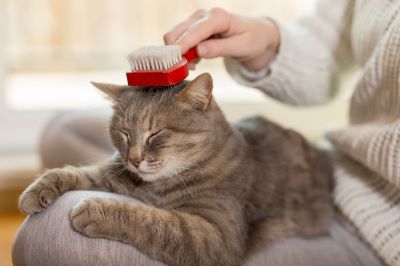The basics on brushing your cat and dog

As a pet owner, it's important to maintain your cat or dog's coat to keep them healthy and happy. Regular brushing not only removes dirt and tangles, but it also helps distribute natural oils and stimulates blood flow to the skin. But how often should you be brushing your pet? And what's the best way to do it?
How often should I brush my pet?
How often you brush your cat or dog really depends on the length and type of coat they have. Short-haired cats or dogs may only need to be brushed once a week, while long-haired breeds may require daily grooming. Breeds with thick undercoats, like huskies or golden retrievers, may need even more frequent brushing during shedding season.
In addition to the length of their coat, there are other factors to consider too, such as your pet’s age, general health and lifestyle. Older pets or those with certain medical conditions may not groom themselves as thoroughly as they used to, while active pets that spend a lot of time outside may get dirtier more quickly.
The power of protein
Both cats and dogs need high-quality protein for muscle health, and it's important to choose a food that specifies the actual protein source. Look for foods with ingredients like chicken, beef, or fish and avoid those that list vague, generic terms like "meat meal", "by-products" or “offal”. If it doesn’t sound appealing to you, it’s unlikely to be appetising for your pet.
Healthy fats
Fat is also crucial for both cats and dogs, providing energy and promoting healthy skin and coats. Opt for high-quality fat sources like chicken fat, fish oil, or flaxseed oil, and be mindful of unhealthy saturated or trans fats that can lead to health issues like obesity.
Portion control
When it comes to portion sizes, follow the guidelines on the packaging or seek advice from your vet. Have a think about how active your pet is each day, as working animals will require more nutrient-dense food than pets. If you notice your pet gaining weight, it may be time to increase their activity levels or cut back on their food to avoid health issues like arthritis or obesity.
Wet or dry?
Don’t stress too much if you aren’t sure whether to choose wet or dry food - there are no hard and fast rules, and both have their advantages. Wet food can be a great choice for fussy eaters or pets with dental issues, while dry food encourages chewing and helps keep teeth clean. Consider trying both options to see what your pet prefers.
Be careful if switching diets
Remember to monitor your pet's progress after switching to a new food. Keep an eye on their weight, eating habits, energy levels, and overall health, and consult with your vet if you have any concerns. If you decide to switch to another food later on, be sure to do so gradually over the space of a week to avoid upsetting their tummy.
Feeding your pet the right diet will play a vital role in keeping their body and mind healthy, and of course, they’ll be happier too.
